MERCEDES-BENZ SPRINTER 2006 Service Manual
Manufacturer: MERCEDES-BENZ, Model Year: 2006, Model line: SPRINTER, Model: MERCEDES-BENZ SPRINTER 2006Pages: 2305, PDF Size: 48.12 MB
Page 2091 of 2305

INSTALLATION
NOTE: Be certain to add refrigerant oil if the rear
A/C condenser is being replaced. The refrigerant oil
must be drained from the old condenser and mea-
sured to determine the amount of refrigerant oil to
add to the new condenser. Use only refrigerant oil
of the type recommended for the rear A/C compres-
sor in the vehicle.
(1) If the rear A/C condenser is being replaced,
install the correct amount and type of refrigerant oil
into the new rear A/C condenser. Drain the old con-
denser and measure the refrigerant oil. Fill the new
condenser with the same amount of new refrigerant
oil that was drained out of the old condenser.
(2) Install new body sealant and any removed
shims onto the top of the roof panel.
(3) With help from an assistant, position the rear
A/C condenser housing onto the top of the roof panel.
(4) Install the eight nuts and washers that secure
the rear A/C condenser housing to the roof panel.
Tighten the nuts to 25 N´m (18 ft. lbs.).
(5) Remove the tape or plugs from the rear liquid
line fitting and rear refrigerant reservoir port.
(6) Lubricate a new O-ring seal with clean refrig-
erant oil and install it onto the rear liquid line fit-
ting. Use only the specified O-ring seal as it is madeof a special material for the R-134a system. Use only
refrigerant oil of the type recommended for the rear
A/C compressor in the vehicle.
(7) Connect the rear liquid line to the rear refrig-
erant reservoir outlet. Tighten the liquid line nut to
35 N´m (26 ft. lbs.).
(8) Remove the tape or plugs from the rear dis-
charge line fitting and rear condenser port.
(9) Lubricate a new O-ring seal with clean refrig-
erant oil and install it onto the rear discharge line
fitting. Use only the specified O-ring seal as it is
made of a special material for the R-134a system.
Use only refrigerant oil of the type recommended for
the rear A/C compressor in the vehicle.
(10) Connect the rear discharge line to the rear
A/C condenser. Tighten the discharge line nut to 35
N´m (26 ft. lbs.).
(11) Install the bracket and screw that secures the
rear discharge line to the right side of the rear con-
denser housing. Tighten the screw securely.
(12) Connect the rear A/C wire harness to the rear
blower motor suppression filter and to the rear A/C
high pressure switch.
(13) Install new retaining straps to secure the rear
A/C wire harness to the rear liquid line.
(14) Install a new rear receiver/drier (Refer to 24 -
HEATING & AIR CONDITIONING/PLUMBING/
REAR RECEIVER/DRIER - INSTALLATION).
Fig. 2 Rear A/C Condenser Housing
1 - REAR A/C CONDENSER HOUSING
2 - LIQUID LINE
3 - REAR REFRIGERANT RESERVOIR
4 - REAR A/C HIGH PRESSURE SWITCH
5 - REAR CONDENSER OUTLET TUBE6 - SUCTION LINE
7 - NUT AND WASHER (8)
8 - REAR A/C WIRE HARNESS
9 - REAR BLOWER MOTOR SUPPRESSION FILTER
24 - 54 DISTRIBUTION - REARVA
Page 2092 of 2305
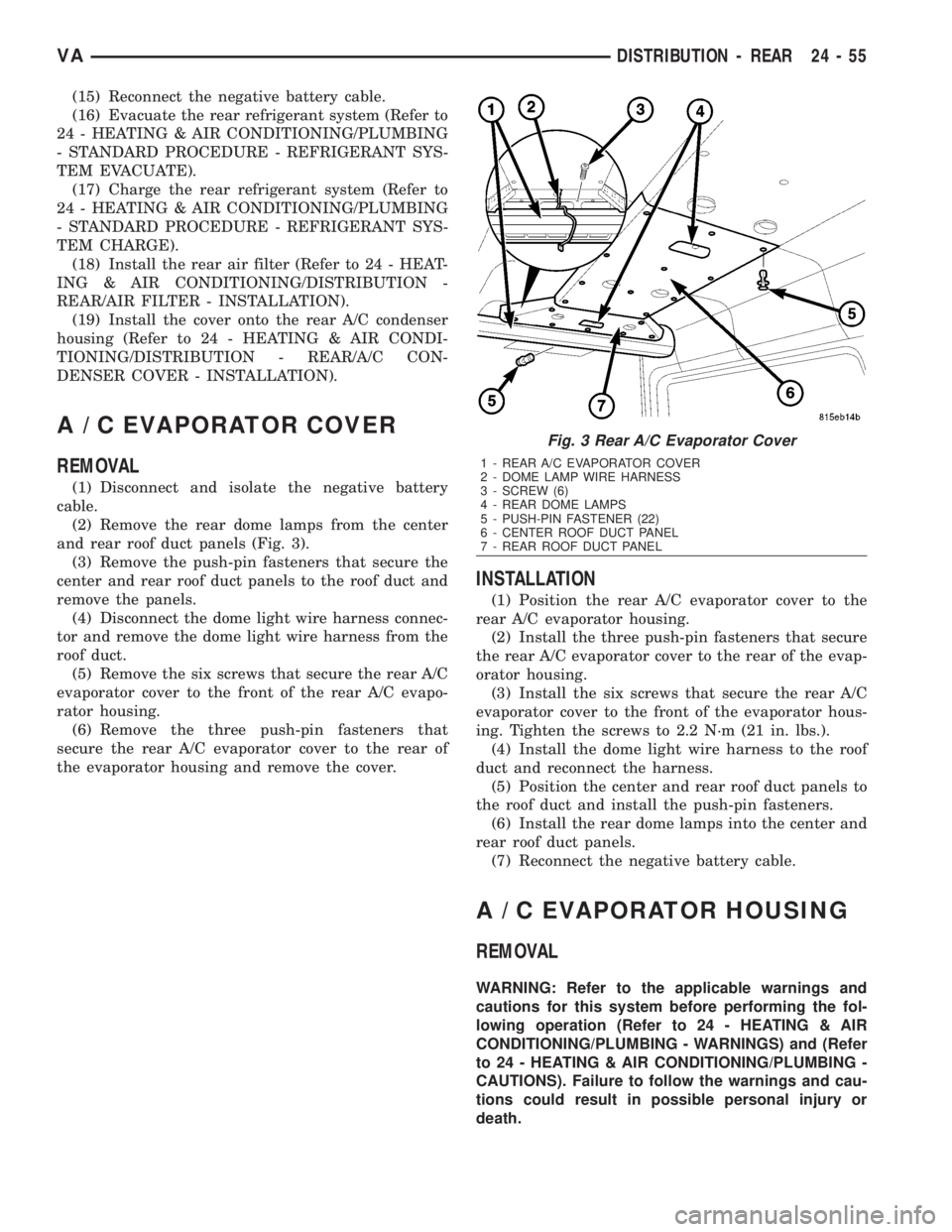
(15) Reconnect the negative battery cable.
(16) Evacuate the rear refrigerant system (Refer to
24 - HEATING & AIR CONDITIONING/PLUMBING
- STANDARD PROCEDURE - REFRIGERANT SYS-
TEM EVACUATE).
(17) Charge the rear refrigerant system (Refer to
24 - HEATING & AIR CONDITIONING/PLUMBING
- STANDARD PROCEDURE - REFRIGERANT SYS-
TEM CHARGE).
(18) Install the rear air filter (Refer to 24 - HEAT-
ING & AIR CONDITIONING/DISTRIBUTION -
REAR/AIR FILTER - INSTALLATION).
(19) Install the cover onto the rear A/C condenser
housing (Refer to 24 - HEATING & AIR CONDI-
TIONING/DISTRIBUTION - REAR/A/C CON-
DENSER COVER - INSTALLATION).
A/CEVAPORATOR COVER
REMOVAL
(1) Disconnect and isolate the negative battery
cable.
(2) Remove the rear dome lamps from the center
and rear roof duct panels (Fig. 3).
(3) Remove the push-pin fasteners that secure the
center and rear roof duct panels to the roof duct and
remove the panels.
(4) Disconnect the dome light wire harness connec-
tor and remove the dome light wire harness from the
roof duct.
(5) Remove the six screws that secure the rear A/C
evaporator cover to the front of the rear A/C evapo-
rator housing.
(6) Remove the three push-pin fasteners that
secure the rear A/C evaporator cover to the rear of
the evaporator housing and remove the cover.
INSTALLATION
(1) Position the rear A/C evaporator cover to the
rear A/C evaporator housing.
(2) Install the three push-pin fasteners that secure
the rear A/C evaporator cover to the rear of the evap-
orator housing.
(3) Install the six screws that secure the rear A/C
evaporator cover to the front of the evaporator hous-
ing. Tighten the screws to 2.2 N´m (21 in. lbs.).
(4) Install the dome light wire harness to the roof
duct and reconnect the harness.
(5) Position the center and rear roof duct panels to
the roof duct and install the push-pin fasteners.
(6) Install the rear dome lamps into the center and
rear roof duct panels.
(7) Reconnect the negative battery cable.
A/CEVAPORATOR HOUSING
REMOVAL
WARNING: Refer to the applicable warnings and
cautions for this system before performing the fol-
lowing operation (Refer to 24 - HEATING & AIR
CONDITIONING/PLUMBING - WARNINGS) and (Refer
to 24 - HEATING & AIR CONDITIONING/PLUMBING -
CAUTIONS). Failure to follow the warnings and cau-
tions could result in possible personal injury or
death.
Fig. 3 Rear A/C Evaporator Cover
1 - REAR A/C EVAPORATOR COVER
2 - DOME LAMP WIRE HARNESS
3 - SCREW (6)
4 - REAR DOME LAMPS
5 - PUSH-PIN FASTENER (22)
6 - CENTER ROOF DUCT PANEL
7 - REAR ROOF DUCT PANEL
VADISTRIBUTION - REAR 24 - 55
Page 2093 of 2305
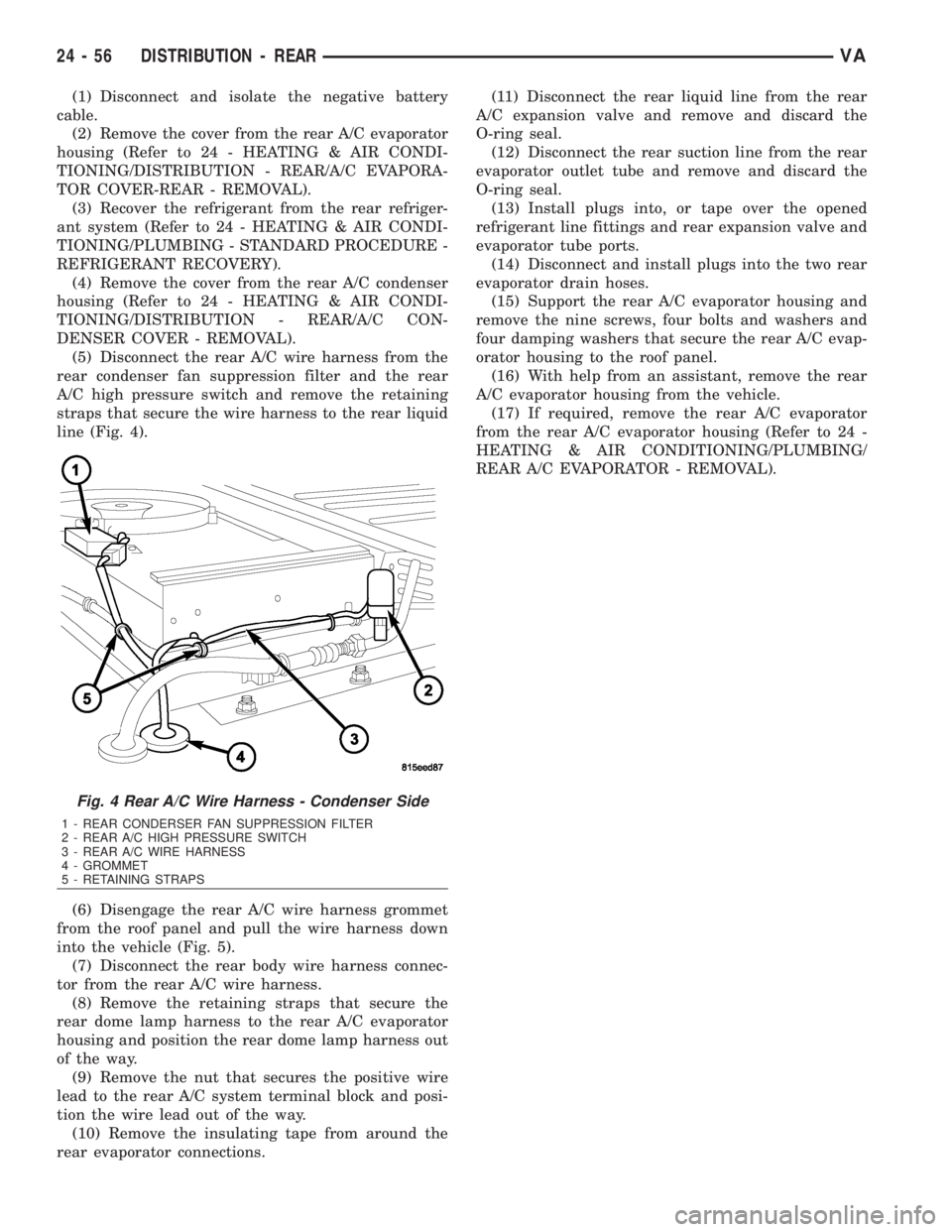
(1) Disconnect and isolate the negative battery
cable.
(2) Remove the cover from the rear A/C evaporator
housing (Refer to 24 - HEATING & AIR CONDI-
TIONING/DISTRIBUTION - REAR/A/C EVAPORA-
TOR COVER-REAR - REMOVAL).
(3) Recover the refrigerant from the rear refriger-
ant system (Refer to 24 - HEATING & AIR CONDI-
TIONING/PLUMBING - STANDARD PROCEDURE -
REFRIGERANT RECOVERY).
(4) Remove the cover from the rear A/C condenser
housing (Refer to 24 - HEATING & AIR CONDI-
TIONING/DISTRIBUTION - REAR/A/C CON-
DENSER COVER - REMOVAL).
(5) Disconnect the rear A/C wire harness from the
rear condenser fan suppression filter and the rear
A/C high pressure switch and remove the retaining
straps that secure the wire harness to the rear liquid
line (Fig. 4).
(6) Disengage the rear A/C wire harness grommet
from the roof panel and pull the wire harness down
into the vehicle (Fig. 5).
(7) Disconnect the rear body wire harness connec-
tor from the rear A/C wire harness.
(8) Remove the retaining straps that secure the
rear dome lamp harness to the rear A/C evaporator
housing and position the rear dome lamp harness out
of the way.
(9) Remove the nut that secures the positive wire
lead to the rear A/C system terminal block and posi-
tion the wire lead out of the way.
(10) Remove the insulating tape from around the
rear evaporator connections.(11) Disconnect the rear liquid line from the rear
A/C expansion valve and remove and discard the
O-ring seal.
(12) Disconnect the rear suction line from the rear
evaporator outlet tube and remove and discard the
O-ring seal.
(13) Install plugs into, or tape over the opened
refrigerant line fittings and rear expansion valve and
evaporator tube ports.
(14) Disconnect and install plugs into the two rear
evaporator drain hoses.
(15) Support the rear A/C evaporator housing and
remove the nine screws, four bolts and washers and
four damping washers that secure the rear A/C evap-
orator housing to the roof panel.
(16) With help from an assistant, remove the rear
A/C evaporator housing from the vehicle.
(17) If required, remove the rear A/C evaporator
from the rear A/C evaporator housing (Refer to 24 -
HEATING & AIR CONDITIONING/PLUMBING/
REAR A/C EVAPORATOR - REMOVAL).
Fig. 4 Rear A/C Wire Harness - Condenser Side
1 - REAR CONDERSER FAN SUPPRESSION FILTER
2 - REAR A/C HIGH PRESSURE SWITCH
3 - REAR A/C WIRE HARNESS
4 - GROMMET
5 - RETAINING STRAPS
24 - 56 DISTRIBUTION - REARVA
Page 2094 of 2305
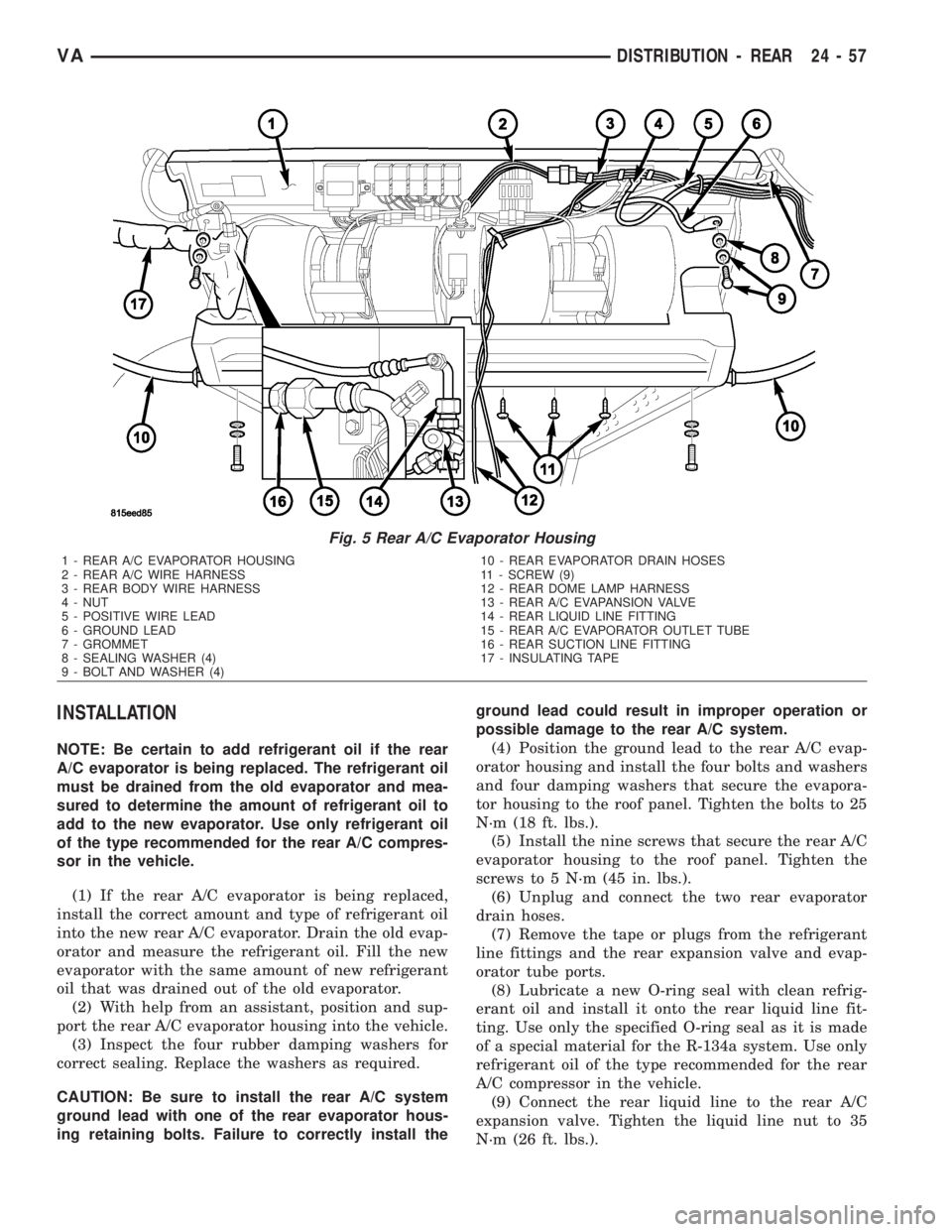
INSTALLATION
NOTE: Be certain to add refrigerant oil if the rear
A/C evaporator is being replaced. The refrigerant oil
must be drained from the old evaporator and mea-
sured to determine the amount of refrigerant oil to
add to the new evaporator. Use only refrigerant oil
of the type recommended for the rear A/C compres-
sor in the vehicle.
(1) If the rear A/C evaporator is being replaced,
install the correct amount and type of refrigerant oil
into the new rear A/C evaporator. Drain the old evap-
orator and measure the refrigerant oil. Fill the new
evaporator with the same amount of new refrigerant
oil that was drained out of the old evaporator.
(2) With help from an assistant, position and sup-
port the rear A/C evaporator housing into the vehicle.
(3) Inspect the four rubber damping washers for
correct sealing. Replace the washers as required.
CAUTION: Be sure to install the rear A/C system
ground lead with one of the rear evaporator hous-
ing retaining bolts. Failure to correctly install theground lead could result in improper operation or
possible damage to the rear A/C system.
(4) Position the ground lead to the rear A/C evap-
orator housing and install the four bolts and washers
and four damping washers that secure the evapora-
tor housing to the roof panel. Tighten the bolts to 25
N´m (18 ft. lbs.).
(5) Install the nine screws that secure the rear A/C
evaporator housing to the roof panel. Tighten the
screws to 5 N´m (45 in. lbs.).
(6) Unplug and connect the two rear evaporator
drain hoses.
(7) Remove the tape or plugs from the refrigerant
line fittings and the rear expansion valve and evap-
orator tube ports.
(8) Lubricate a new O-ring seal with clean refrig-
erant oil and install it onto the rear liquid line fit-
ting. Use only the specified O-ring seal as it is made
of a special material for the R-134a system. Use only
refrigerant oil of the type recommended for the rear
A/C compressor in the vehicle.
(9) Connect the rear liquid line to the rear A/C
expansion valve. Tighten the liquid line nut to 35
N´m (26 ft. lbs.).
Fig. 5 Rear A/C Evaporator Housing
1 - REAR A/C EVAPORATOR HOUSING
2 - REAR A/C WIRE HARNESS
3 - REAR BODY WIRE HARNESS
4 - NUT
5 - POSITIVE WIRE LEAD
6 - GROUND LEAD
7 - GROMMET
8 - SEALING WASHER (4)
9 - BOLT AND WASHER (4)10 - REAR EVAPORATOR DRAIN HOSES
11 - SCREW (9)
12 - REAR DOME LAMP HARNESS
13 - REAR A/C EVAPANSION VALVE
14 - REAR LIQUID LINE FITTING
15 - REAR A/C EVAPORATOR OUTLET TUBE
16 - REAR SUCTION LINE FITTING
17 - INSULATING TAPE
VADISTRIBUTION - REAR 24 - 57
Page 2095 of 2305
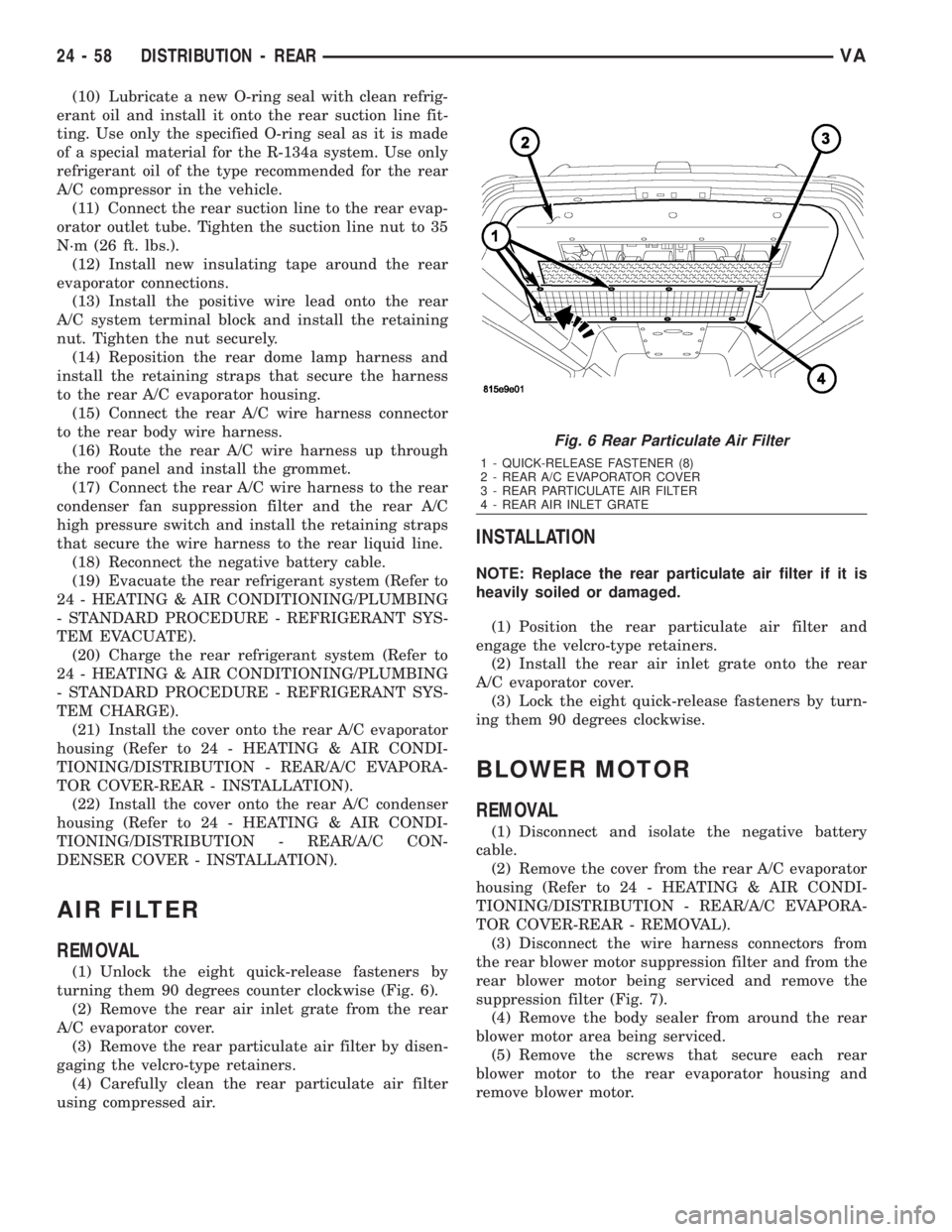
(10) Lubricate a new O-ring seal with clean refrig-
erant oil and install it onto the rear suction line fit-
ting. Use only the specified O-ring seal as it is made
of a special material for the R-134a system. Use only
refrigerant oil of the type recommended for the rear
A/C compressor in the vehicle.
(11) Connect the rear suction line to the rear evap-
orator outlet tube. Tighten the suction line nut to 35
N´m (26 ft. lbs.).
(12) Install new insulating tape around the rear
evaporator connections.
(13) Install the positive wire lead onto the rear
A/C system terminal block and install the retaining
nut. Tighten the nut securely.
(14) Reposition the rear dome lamp harness and
install the retaining straps that secure the harness
to the rear A/C evaporator housing.
(15) Connect the rear A/C wire harness connector
to the rear body wire harness.
(16) Route the rear A/C wire harness up through
the roof panel and install the grommet.
(17) Connect the rear A/C wire harness to the rear
condenser fan suppression filter and the rear A/C
high pressure switch and install the retaining straps
that secure the wire harness to the rear liquid line.
(18) Reconnect the negative battery cable.
(19) Evacuate the rear refrigerant system (Refer to
24 - HEATING & AIR CONDITIONING/PLUMBING
- STANDARD PROCEDURE - REFRIGERANT SYS-
TEM EVACUATE).
(20) Charge the rear refrigerant system (Refer to
24 - HEATING & AIR CONDITIONING/PLUMBING
- STANDARD PROCEDURE - REFRIGERANT SYS-
TEM CHARGE).
(21) Install the cover onto the rear A/C evaporator
housing (Refer to 24 - HEATING & AIR CONDI-
TIONING/DISTRIBUTION - REAR/A/C EVAPORA-
TOR COVER-REAR - INSTALLATION).
(22) Install the cover onto the rear A/C condenser
housing (Refer to 24 - HEATING & AIR CONDI-
TIONING/DISTRIBUTION - REAR/A/C CON-
DENSER COVER - INSTALLATION).
AIR FILTER
REMOVAL
(1) Unlock the eight quick-release fasteners by
turning them 90 degrees counter clockwise (Fig. 6).
(2) Remove the rear air inlet grate from the rear
A/C evaporator cover.
(3) Remove the rear particulate air filter by disen-
gaging the velcro-type retainers.
(4) Carefully clean the rear particulate air filter
using compressed air.
INSTALLATION
NOTE: Replace the rear particulate air filter if it is
heavily soiled or damaged.
(1) Position the rear particulate air filter and
engage the velcro-type retainers.
(2) Install the rear air inlet grate onto the rear
A/C evaporator cover.
(3) Lock the eight quick-release fasteners by turn-
ing them 90 degrees clockwise.
BLOWER MOTOR
REMOVAL
(1) Disconnect and isolate the negative battery
cable.
(2) Remove the cover from the rear A/C evaporator
housing (Refer to 24 - HEATING & AIR CONDI-
TIONING/DISTRIBUTION - REAR/A/C EVAPORA-
TOR COVER-REAR - REMOVAL).
(3) Disconnect the wire harness connectors from
the rear blower motor suppression filter and from the
rear blower motor being serviced and remove the
suppression filter (Fig. 7).
(4) Remove the body sealer from around the rear
blower motor area being serviced.
(5) Remove the screws that secure each rear
blower motor to the rear evaporator housing and
remove blower motor.
Fig. 6 Rear Particulate Air Filter
1 - QUICK-RELEASE FASTENER (8)
2 - REAR A/C EVAPORATOR COVER
3 - REAR PARTICULATE AIR FILTER
4 - REAR AIR INLET GRATE
24 - 58 DISTRIBUTION - REARVA
Page 2096 of 2305
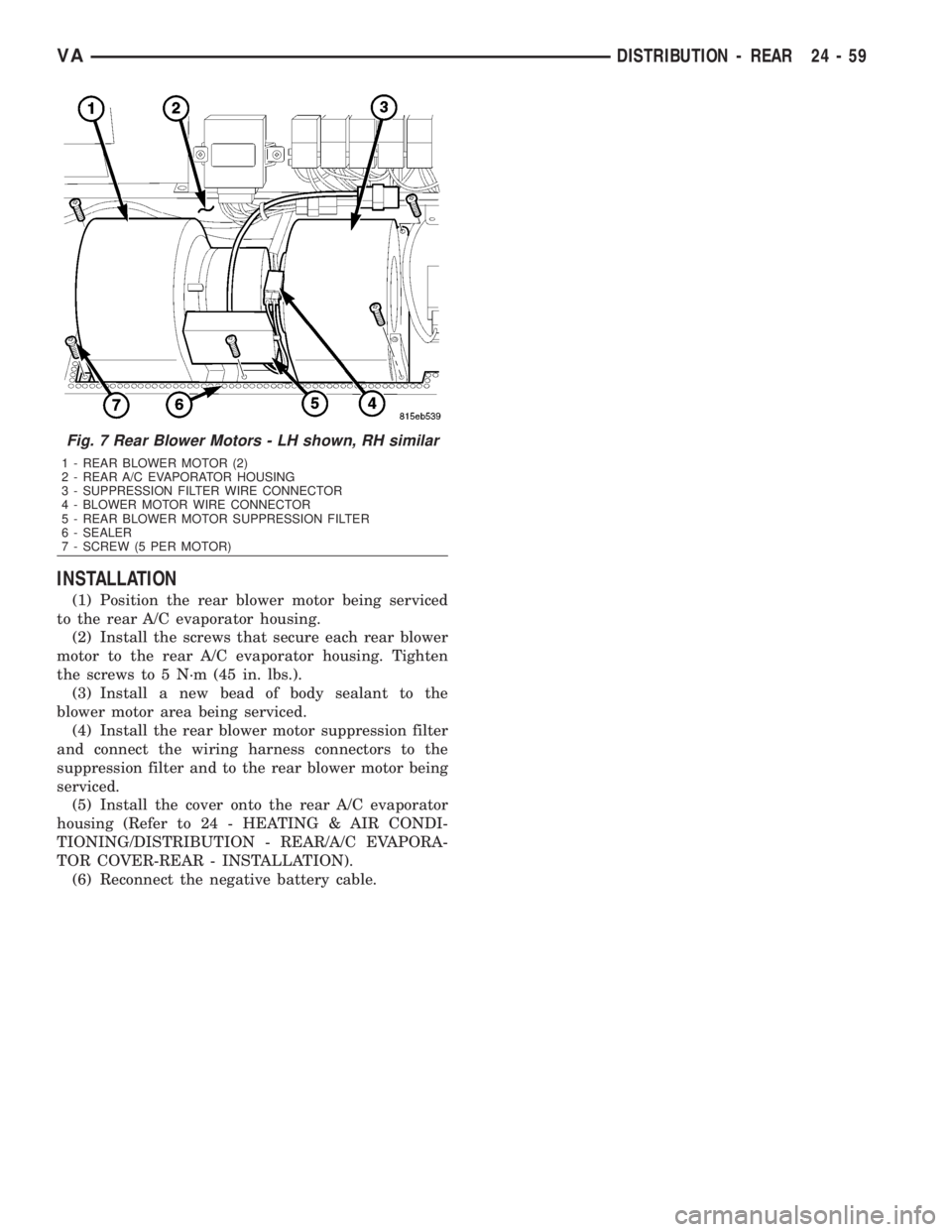
INSTALLATION
(1) Position the rear blower motor being serviced
to the rear A/C evaporator housing.
(2) Install the screws that secure each rear blower
motor to the rear A/C evaporator housing. Tighten
the screws to 5 N´m (45 in. lbs.).
(3) Install a new bead of body sealant to the
blower motor area being serviced.
(4) Install the rear blower motor suppression filter
and connect the wiring harness connectors to the
suppression filter and to the rear blower motor being
serviced.
(5) Install the cover onto the rear A/C evaporator
housing (Refer to 24 - HEATING & AIR CONDI-
TIONING/DISTRIBUTION - REAR/A/C EVAPORA-
TOR COVER-REAR - INSTALLATION).
(6) Reconnect the negative battery cable.
Fig. 7 Rear Blower Motors - LH shown, RH similar
1 - REAR BLOWER MOTOR (2)
2 - REAR A/C EVAPORATOR HOUSING
3 - SUPPRESSION FILTER WIRE CONNECTOR
4 - BLOWER MOTOR WIRE CONNECTOR
5 - REAR BLOWER MOTOR SUPPRESSION FILTER
6 - SEALER
7 - SCREW (5 PER MOTOR)
VADISTRIBUTION - REAR 24 - 59
Page 2097 of 2305
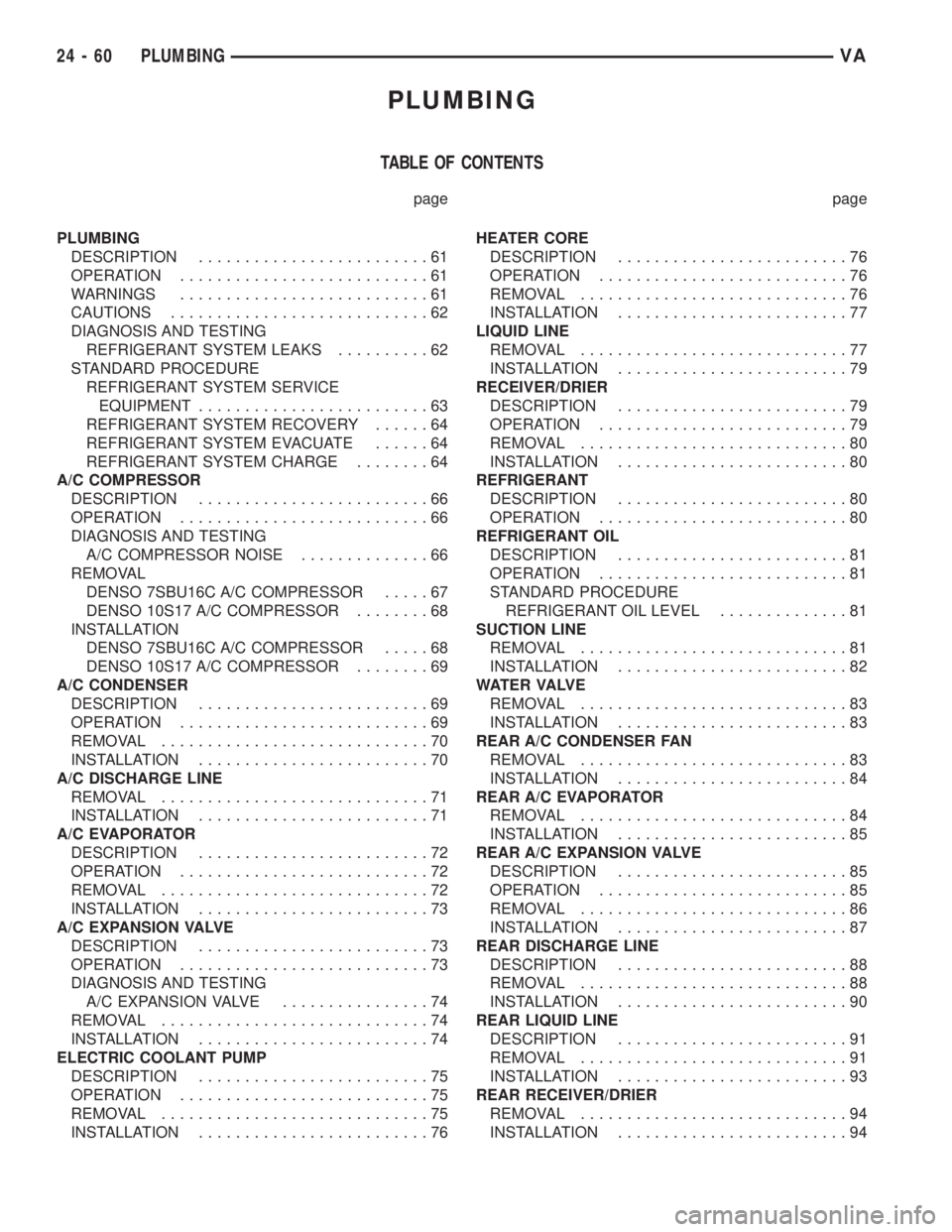
PLUMBING
TABLE OF CONTENTS
page page
PLUMBING
DESCRIPTION.........................61
OPERATION...........................61
WARNINGS...........................61
CAUTIONS............................62
DIAGNOSIS AND TESTING
REFRIGERANT SYSTEM LEAKS..........62
STANDARD PROCEDURE
REFRIGERANT SYSTEM SERVICE
EQUIPMENT.........................63
REFRIGERANT SYSTEM RECOVERY......64
REFRIGERANT SYSTEM EVACUATE......64
REFRIGERANT SYSTEM CHARGE........64
A/C COMPRESSOR
DESCRIPTION.........................66
OPERATION...........................66
DIAGNOSIS AND TESTING
A/C COMPRESSOR NOISE..............66
REMOVAL
DENSO 7SBU16C A/C COMPRESSOR.....67
DENSO 10S17 A/C COMPRESSOR........68
INSTALLATION
DENSO 7SBU16C A/C COMPRESSOR.....68
DENSO 10S17 A/C COMPRESSOR........69
A/C CONDENSER
DESCRIPTION.........................69
OPERATION...........................69
REMOVAL.............................70
INSTALLATION.........................70
A/C DISCHARGE LINE
REMOVAL.............................71
INSTALLATION.........................71
A/C EVAPORATOR
DESCRIPTION.........................72
OPERATION...........................72
REMOVAL.............................72
INSTALLATION.........................73
A/C EXPANSION VALVE
DESCRIPTION.........................73
OPERATION...........................73
DIAGNOSIS AND TESTING
A/C EXPANSION VALVE................74
REMOVAL.............................74
INSTALLATION.........................74
ELECTRIC COOLANT PUMP
DESCRIPTION.........................75
OPERATION...........................75
REMOVAL.............................75
INSTALLATION.........................76HEATER CORE
DESCRIPTION.........................76
OPERATION...........................76
REMOVAL.............................76
INSTALLATION.........................77
LIQUID LINE
REMOVAL.............................77
INSTALLATION.........................79
RECEIVER/DRIER
DESCRIPTION.........................79
OPERATION...........................79
REMOVAL.............................80
INSTALLATION.........................80
REFRIGERANT
DESCRIPTION.........................80
OPERATION...........................80
REFRIGERANT OIL
DESCRIPTION.........................81
OPERATION...........................81
STANDARD PROCEDURE
REFRIGERANT OIL LEVEL..............81
SUCTION LINE
REMOVAL.............................81
INSTALLATION.........................82
WAT E R VA LV E
REMOVAL.............................83
INSTALLATION.........................83
REAR A/C CONDENSER FAN
REMOVAL.............................83
INSTALLATION.........................84
REAR A/C EVAPORATOR
REMOVAL.............................84
INSTALLATION.........................85
REAR A/C EXPANSION VALVE
DESCRIPTION.........................85
OPERATION...........................85
REMOVAL.............................86
INSTALLATION.........................87
REAR DISCHARGE LINE
DESCRIPTION.........................88
REMOVAL.............................88
INSTALLATION.........................90
REAR LIQUID LINE
DESCRIPTION.........................91
REMOVAL.............................91
INSTALLATION.........................93
REAR RECEIVER/DRIER
REMOVAL.............................94
INSTALLATION.........................94
24 - 60 PLUMBINGVA
Page 2098 of 2305
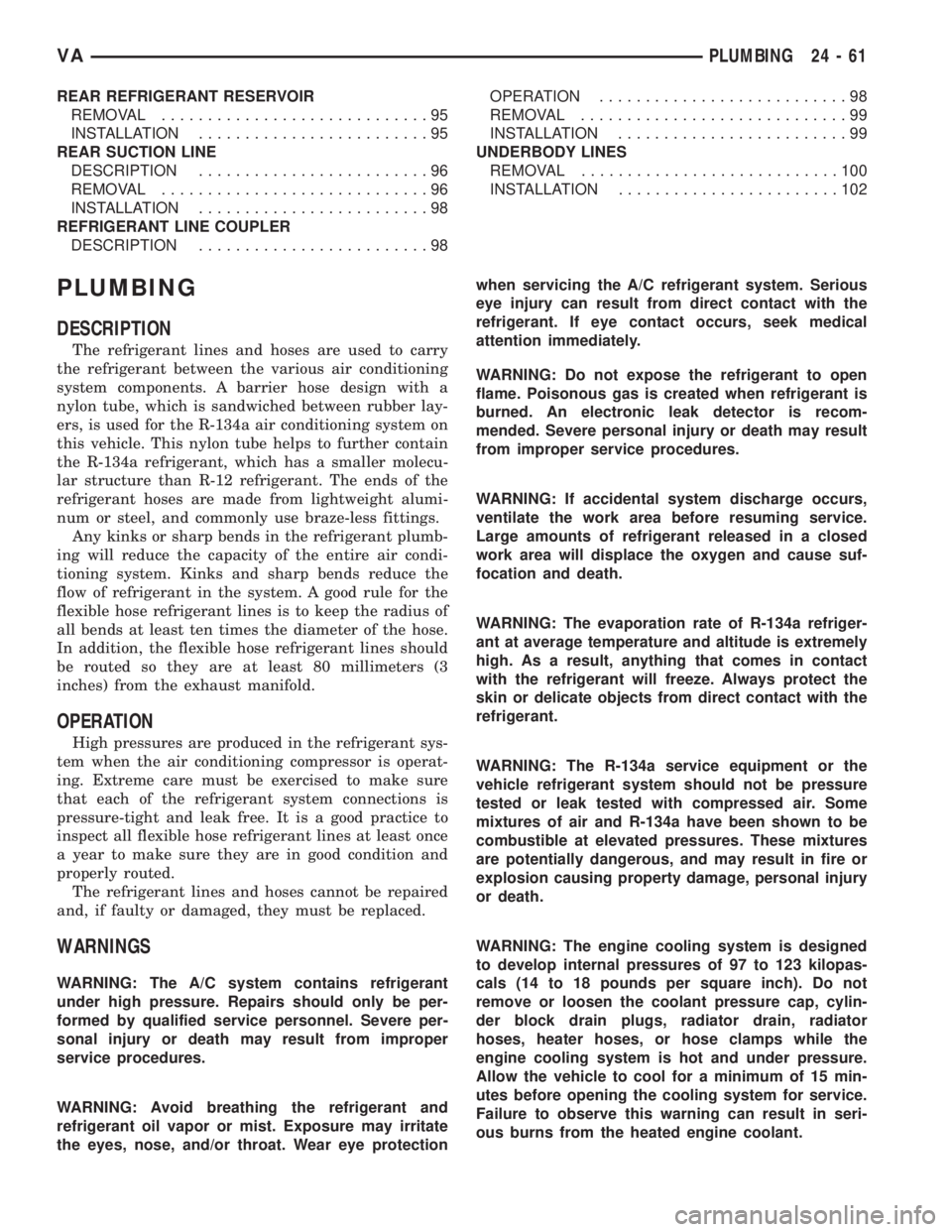
REAR REFRIGERANT RESERVOIR
REMOVAL.............................95
INSTALLATION.........................95
REAR SUCTION LINE
DESCRIPTION.........................96
REMOVAL.............................96
INSTALLATION.........................98
REFRIGERANT LINE COUPLER
DESCRIPTION.........................98OPERATION...........................98
REMOVAL.............................99
INSTALLATION.........................99
UNDERBODY LINES
REMOVAL............................100
INSTALLATION........................102
PLUMBING
DESCRIPTION
The refrigerant lines and hoses are used to carry
the refrigerant between the various air conditioning
system components. A barrier hose design with a
nylon tube, which is sandwiched between rubber lay-
ers, is used for the R-134a air conditioning system on
this vehicle. This nylon tube helps to further contain
the R-134a refrigerant, which has a smaller molecu-
lar structure than R-12 refrigerant. The ends of the
refrigerant hoses are made from lightweight alumi-
num or steel, and commonly use braze-less fittings.
Any kinks or sharp bends in the refrigerant plumb-
ing will reduce the capacity of the entire air condi-
tioning system. Kinks and sharp bends reduce the
flow of refrigerant in the system. A good rule for the
flexible hose refrigerant lines is to keep the radius of
all bends at least ten times the diameter of the hose.
In addition, the flexible hose refrigerant lines should
be routed so they are at least 80 millimeters (3
inches) from the exhaust manifold.
OPERATION
High pressures are produced in the refrigerant sys-
tem when the air conditioning compressor is operat-
ing. Extreme care must be exercised to make sure
that each of the refrigerant system connections is
pressure-tight and leak free. It is a good practice to
inspect all flexible hose refrigerant lines at least once
a year to make sure they are in good condition and
properly routed.
The refrigerant lines and hoses cannot be repaired
and, if faulty or damaged, they must be replaced.
WARNINGS
WARNING: The A/C system contains refrigerant
under high pressure. Repairs should only be per-
formed by qualified service personnel. Severe per-
sonal injury or death may result from improper
service procedures.
WARNING: Avoid breathing the refrigerant and
refrigerant oil vapor or mist. Exposure may irritate
the eyes, nose, and/or throat. Wear eye protectionwhen servicing the A/C refrigerant system. Serious
eye injury can result from direct contact with the
refrigerant. If eye contact occurs, seek medical
attention immediately.
WARNING: Do not expose the refrigerant to open
flame. Poisonous gas is created when refrigerant is
burned. An electronic leak detector is recom-
mended. Severe personal injury or death may result
from improper service procedures.
WARNING: If accidental system discharge occurs,
ventilate the work area before resuming service.
Large amounts of refrigerant released in a closed
work area will displace the oxygen and cause suf-
focation and death.
WARNING: The evaporation rate of R-134a refriger-
ant at average temperature and altitude is extremely
high. As a result, anything that comes in contact
with the refrigerant will freeze. Always protect the
skin or delicate objects from direct contact with the
refrigerant.
WARNING: The R-134a service equipment or the
vehicle refrigerant system should not be pressure
tested or leak tested with compressed air. Some
mixtures of air and R-134a have been shown to be
combustible at elevated pressures. These mixtures
are potentially dangerous, and may result in fire or
explosion causing property damage, personal injury
or death.
WARNING: The engine cooling system is designed
to develop internal pressures of 97 to 123 kilopas-
cals (14 to 18 pounds per square inch). Do not
remove or loosen the coolant pressure cap, cylin-
der block drain plugs, radiator drain, radiator
hoses, heater hoses, or hose clamps while the
engine cooling system is hot and under pressure.
Allow the vehicle to cool for a minimum of 15 min-
utes before opening the cooling system for service.
Failure to observe this warning can result in seri-
ous burns from the heated engine coolant.
VAPLUMBING 24 - 61
Page 2099 of 2305
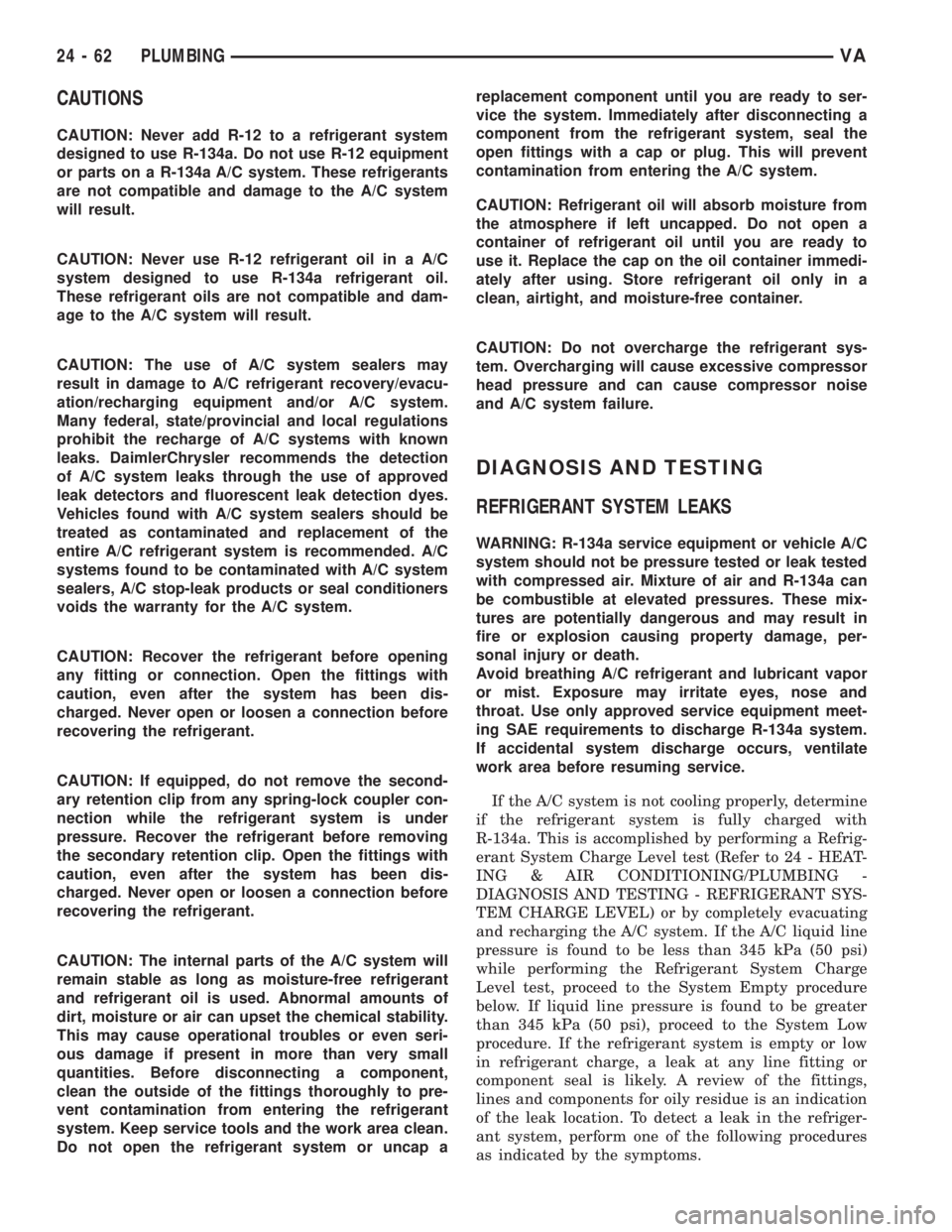
CAUTIONS
CAUTION: Never add R-12 to a refrigerant system
designed to use R-134a. Do not use R-12 equipment
or parts on a R-134a A/C system. These refrigerants
are not compatible and damage to the A/C system
will result.
CAUTION: Never use R-12 refrigerant oil in a A/C
system designed to use R-134a refrigerant oil.
These refrigerant oils are not compatible and dam-
age to the A/C system will result.
CAUTION: The use of A/C system sealers may
result in damage to A/C refrigerant recovery/evacu-
ation/recharging equipment and/or A/C system.
Many federal, state/provincial and local regulations
prohibit the recharge of A/C systems with known
leaks. DaimlerChrysler recommends the detection
of A/C system leaks through the use of approved
leak detectors and fluorescent leak detection dyes.
Vehicles found with A/C system sealers should be
treated as contaminated and replacement of the
entire A/C refrigerant system is recommended. A/C
systems found to be contaminated with A/C system
sealers, A/C stop-leak products or seal conditioners
voids the warranty for the A/C system.
CAUTION: Recover the refrigerant before opening
any fitting or connection. Open the fittings with
caution, even after the system has been dis-
charged. Never open or loosen a connection before
recovering the refrigerant.
CAUTION: If equipped, do not remove the second-
ary retention clip from any spring-lock coupler con-
nection while the refrigerant system is under
pressure. Recover the refrigerant before removing
the secondary retention clip. Open the fittings with
caution, even after the system has been dis-
charged. Never open or loosen a connection before
recovering the refrigerant.
CAUTION: The internal parts of the A/C system will
remain stable as long as moisture-free refrigerant
and refrigerant oil is used. Abnormal amounts of
dirt, moisture or air can upset the chemical stability.
This may cause operational troubles or even seri-
ous damage if present in more than very small
quantities. Before disconnecting a component,
clean the outside of the fittings thoroughly to pre-
vent contamination from entering the refrigerant
system. Keep service tools and the work area clean.
Do not open the refrigerant system or uncap areplacement component until you are ready to ser-
vice the system. Immediately after disconnecting a
component from the refrigerant system, seal the
open fittings with a cap or plug. This will prevent
contamination from entering the A/C system.
CAUTION: Refrigerant oil will absorb moisture from
the atmosphere if left uncapped. Do not open a
container of refrigerant oil until you are ready to
use it. Replace the cap on the oil container immedi-
ately after using. Store refrigerant oil only in a
clean, airtight, and moisture-free container.
CAUTION: Do not overcharge the refrigerant sys-
tem. Overcharging will cause excessive compressor
head pressure and can cause compressor noise
and A/C system failure.
DIAGNOSIS AND TESTING
REFRIGERANT SYSTEM LEAKS
WARNING: R-134a service equipment or vehicle A/C
system should not be pressure tested or leak tested
with compressed air. Mixture of air and R-134a can
be combustible at elevated pressures. These mix-
tures are potentially dangerous and may result in
fire or explosion causing property damage, per-
sonal injury or death.
Avoid breathing A/C refrigerant and lubricant vapor
or mist. Exposure may irritate eyes, nose and
throat. Use only approved service equipment meet-
ing SAE requirements to discharge R-134a system.
If accidental system discharge occurs, ventilate
work area before resuming service.
If the A/C system is not cooling properly, determine
if the refrigerant system is fully charged with
R-134a. This is accomplished by performing a Refrig-
erant System Charge Level test (Refer to 24 - HEAT-
ING & AIR CONDITIONING/PLUMBING -
DIAGNOSIS AND TESTING - REFRIGERANT SYS-
TEM CHARGE LEVEL) or by completely evacuating
and recharging the A/C system. If the A/C liquid line
pressure is found to be less than 345 kPa (50 psi)
while performing the Refrigerant System Charge
Level test, proceed to the System Empty procedure
below. If liquid line pressure is found to be greater
than 345 kPa (50 psi), proceed to the System Low
procedure. If the refrigerant system is empty or low
in refrigerant charge, a leak at any line fitting or
component seal is likely. A review of the fittings,
lines and components for oily residue is an indication
of the leak location. To detect a leak in the refriger-
ant system, perform one of the following procedures
as indicated by the symptoms.
24 - 62 PLUMBINGVA
Page 2100 of 2305
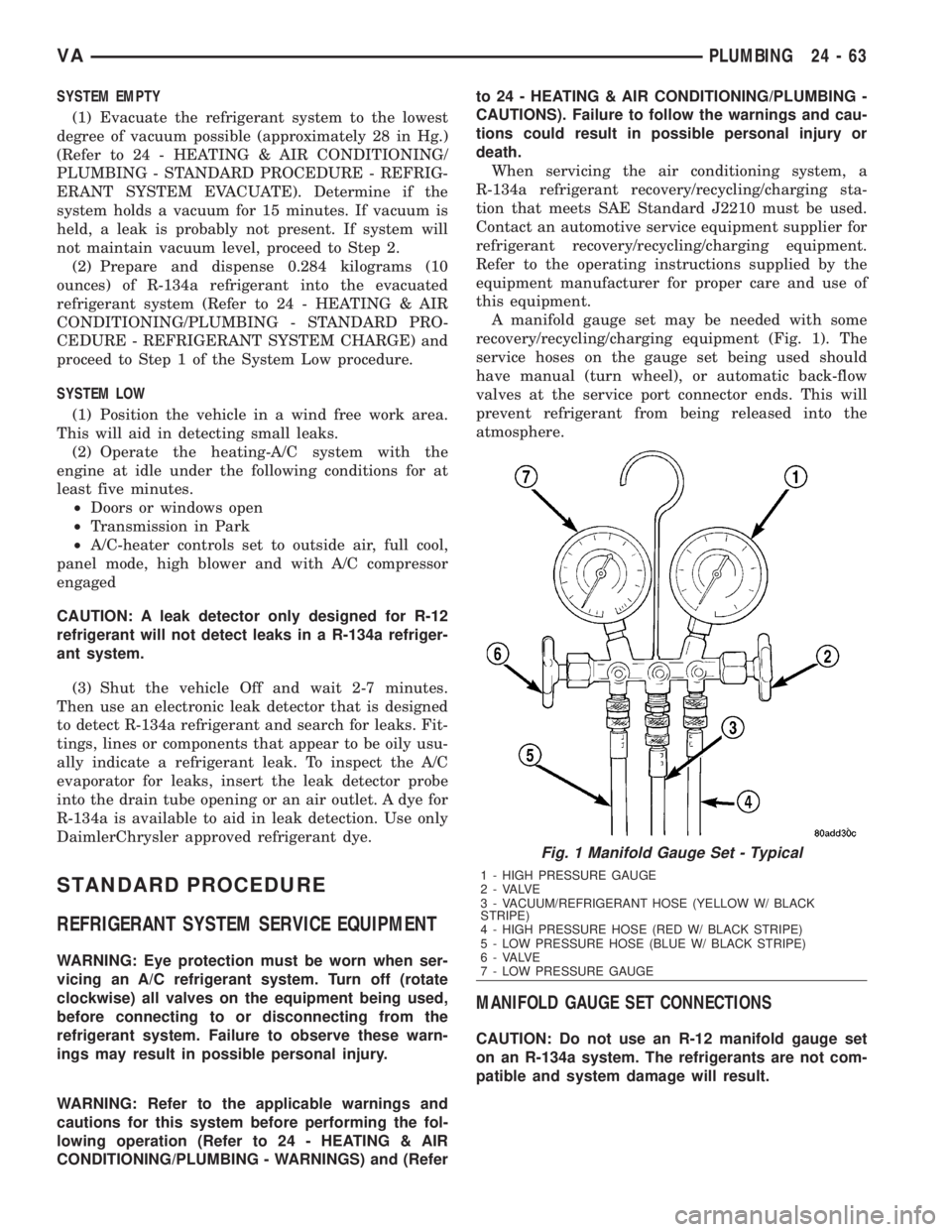
SYSTEM EMPTY
(1) Evacuate the refrigerant system to the lowest
degree of vacuum possible (approximately 28 in Hg.)
(Refer to 24 - HEATING & AIR CONDITIONING/
PLUMBING - STANDARD PROCEDURE - REFRIG-
ERANT SYSTEM EVACUATE). Determine if the
system holds a vacuum for 15 minutes. If vacuum is
held, a leak is probably not present. If system will
not maintain vacuum level, proceed to Step 2.
(2) Prepare and dispense 0.284 kilograms (10
ounces) of R-134a refrigerant into the evacuated
refrigerant system (Refer to 24 - HEATING & AIR
CONDITIONING/PLUMBING - STANDARD PRO-
CEDURE - REFRIGERANT SYSTEM CHARGE) and
proceed to Step 1 of the System Low procedure.
SYSTEM LOW
(1) Position the vehicle in a wind free work area.
This will aid in detecting small leaks.
(2) Operate the heating-A/C system with the
engine at idle under the following conditions for at
least five minutes.
²Doors or windows open
²Transmission in Park
²A/C-heater controls set to outside air, full cool,
panel mode, high blower and with A/C compressor
engaged
CAUTION: A leak detector only designed for R-12
refrigerant will not detect leaks in a R-134a refriger-
ant system.
(3) Shut the vehicle Off and wait 2-7 minutes.
Then use an electronic leak detector that is designed
to detect R-134a refrigerant and search for leaks. Fit-
tings, lines or components that appear to be oily usu-
ally indicate a refrigerant leak. To inspect the A/C
evaporator for leaks, insert the leak detector probe
into the drain tube opening or an air outlet. A dye for
R-134a is available to aid in leak detection. Use only
DaimlerChrysler approved refrigerant dye.
STANDARD PROCEDURE
REFRIGERANT SYSTEM SERVICE EQUIPMENT
WARNING: Eye protection must be worn when ser-
vicing an A/C refrigerant system. Turn off (rotate
clockwise) all valves on the equipment being used,
before connecting to or disconnecting from the
refrigerant system. Failure to observe these warn-
ings may result in possible personal injury.
WARNING: Refer to the applicable warnings and
cautions for this system before performing the fol-
lowing operation (Refer to 24 - HEATING & AIR
CONDITIONING/PLUMBING - WARNINGS) and (Referto 24 - HEATING & AIR CONDITIONING/PLUMBING -
CAUTIONS). Failure to follow the warnings and cau-
tions could result in possible personal injury or
death.
When servicing the air conditioning system, a
R-134a refrigerant recovery/recycling/charging sta-
tion that meets SAE Standard J2210 must be used.
Contact an automotive service equipment supplier for
refrigerant recovery/recycling/charging equipment.
Refer to the operating instructions supplied by the
equipment manufacturer for proper care and use of
this equipment.
A manifold gauge set may be needed with some
recovery/recycling/charging equipment (Fig. 1). The
service hoses on the gauge set being used should
have manual (turn wheel), or automatic back-flow
valves at the service port connector ends. This will
prevent refrigerant from being released into the
atmosphere.
MANIFOLD GAUGE SET CONNECTIONS
CAUTION: Do not use an R-12 manifold gauge set
on an R-134a system. The refrigerants are not com-
patible and system damage will result.
Fig. 1 Manifold Gauge Set - Typical
1 - HIGH PRESSURE GAUGE
2 - VALVE
3 - VACUUM/REFRIGERANT HOSE (YELLOW W/ BLACK
STRIPE)
4 - HIGH PRESSURE HOSE (RED W/ BLACK STRIPE)
5 - LOW PRESSURE HOSE (BLUE W/ BLACK STRIPE)
6 - VALVE
7 - LOW PRESSURE GAUGE
VAPLUMBING 24 - 63